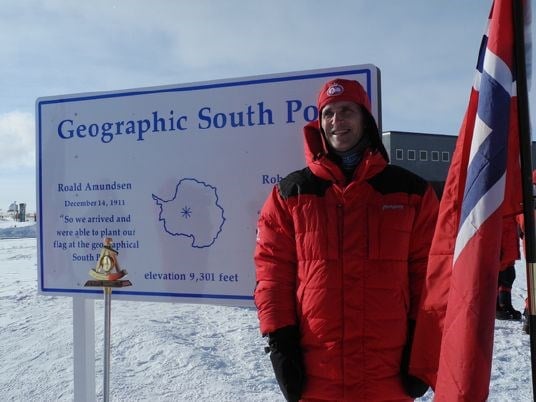Norway’s Prime Minister in Antarctica
Historical archive
Published under: Stoltenberg's 2nd Government
Publisher: Office of the Prime Minister
News story | Date: 13/12/2011
Norwegian Prime Minister Jens Stoltenberg arrived at the South Pole on 12 December. During his visit until 15 December he will underline the importance of the Antarctic continent to better understand the serious climate changes. The Prime Minister will also celebrate the centenary of the arrival of the first expedition to the South Pole.
Norwegian Prime Minister Jens Stoltenberg arrived at the South Pole on 12 December. During his visit until 15 December he will underline the importance of the Antarctic continent to better understand the serious climate changes.
The Prime Minister will also celebrate the centenary of the arrival of the first expedition to the South Pole on 14 December 1911, with Norwegian explorers Roald Amundsen, Olav Bjaaland, Helmer Hanssen, Sverre Hassel and Oscar Wisting.
“This was a major achievement for Norway as a young state”, says Prime Minister Stoltenberg.
The celebration at the South Pole on 14 December is part of Norway’s Nansen-Amundsen Year 2011.
Antarctica
While 1911 saw the race to be the first to reach the South Pole, the Antarctic continent is today a demonstration of international cooperation. The continent is administered jointly by many countries, on the basis of the Antarctic Treaty.
Norway plays an active part in the Antarctic cooperation, and the Prime Minister’s visit is an expression of Norway’s position in Antarctica.
“Norway is a major polar state having considerable interests in Antarctica”, says Prime Minister Stoltenberg.
Climate changes
International scientific research in Antarctica is increasing, with a particular awareness on climate change. The way in which ice, snow and permafrost in polar areas react to global warming due to the rapidly increasing greenhouse gas emissions, will be of major importance to the Earth’s future climate.
The quicker ice and snow is being reduced, the quicker polar areas are warming. This is a self-reinforcing process, and an important reason why polar temperatures are rising considerably quicker than the global average. The warming of sea and atmosphere is leading to a quicker melting of ice in Antarctica and in Greenland. That is also accelerating the raising of the sea level.
“The need for better knowledge about these relations is the reason why the Norwegian Government is intensifying its support for climate research in polar areas, so that global and local consequences may be seen more clearly”, says Stoltenberg.
In 2010 the FRAM – High North Research Centre for Climate and the Environment was established in Tromsø, Norway. The centre will deliver new knowledge on the melting of ice and snow. The Troll Research Station in Queen Maud Land, Antarctica, is the base for a number of research programmes contributing to the understanding of climate change.
“With its presence, infrastructure and research in the Arctic as well as in Antarctica, and with its solid scientific communities, Norway will continue to deliver important contributions to international climate research in the years to come”, says Prime Minister Stoltenberg.

(Foto: Statsministerens kontor.)